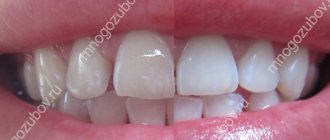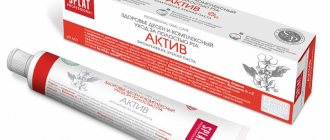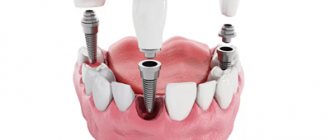Regular and complete oral hygiene is the key to healthy teeth, gums and other structures in this area. Of course, hygiene in this case is based on brushing your teeth, the correct implementation of which today is impossible without the use of toothpaste.
However, the market for oral hygiene products today is crowded. The shelves of stores and pharmacies are full of toothpastes, and the number of their manufacturers is amazing.
In such realities, the question arises - “how to find the best toothpaste that suits me?” To get the answer, you need to have a clear understanding of the classification, as well as the principles for choosing this product for oral hygiene.
What types of toothpastes are there - classification
The ability to choose is an important skill, on which the condition of the structures and health of the oral cavity subsequently depends. An incorrectly selected oral hygiene product can provoke the development of a number of serious problems such as increased tooth sensitivity and bleeding gums.
You may have to visit a dentist before purchasing. The doctor will examine the oral cavity, point out nuances that require adjustments, protect you from making the wrong choice, and tell you what toothpaste you need.
When purchasing, it is important to remember the classification, within which toothpaste is divided into the following types:
- Children's - these do not contain aggressive components, they are known for their gentle effect on the structures of the oral cavity. It is important to pay attention to the age limit indicated on the packaging. When buying children's toothpaste, also make sure that it contains dicalcium phosphate and silicon dioxide, and that the CDV value does not exceed 50 units. It is also important to remember that it is not advisable for an adult to brush their teeth with children’s toothpaste; it is intended primarily for young children and adolescents.
- Whitening - the peculiarity is that this paste contains microparticles of abrasive materials used in dentistry. Thanks to this composition, the whitening helps get rid of stubborn plaque (but does not get rid of tartar). At the same time, tooth whitening paste is not recommended for people with thin enamel or hypersensitive teeth, the problems will worsen.
- Anti-caries - the peculiarities of the chemical composition of this type of hygiene products allow them to penetrate into hard-to-reach places. The components that are included in anti-carious toothpaste help strengthen the enamel layer and reduce tooth sensitivity. This type of toothpaste is used in the initial stages of carious formations; it strengthens the enamel, preventing the spread of caries.
- If there is bleeding, sensitive gums need care. Pastes of this type contain special components (often of natural origin) that have anti-inflammatory, hemostatic and antibacterial effects, and also accelerate tissue regeneration. When using a correctly selected paste of this type, after 20-30 days, inflammation of the gums is eliminated, they stop bleeding, and other problems can be dealt with.
- Hygienic (preventive) - if the previous options had features, then hygienic toothpaste can be called standard. This choice should be made by people with a completely healthy oral cavity, in the absence of complaints of increased tooth sensitivity or thinning of the enamel layer. They have a slight whitening effect, have an antibacterial effect, strengthen enamel and maintain gum health, preventing caries and periodontal disease.
Pastes for the prevention of dental caries
Toothpastes for the prevention of caries are recommended for increased susceptibility to the formation of caries bacteria, as well as as restorative therapy after teeth whitening. They saturate dental tissues with useful minerals, prevent the growth of carious bacteria, and also fight the formation of plaque. To strengthen teeth, fluoride compounds are added to such pastes. It is contained in such pastes as “Day and Night” Swiss Smile, Enzycal 950 CURAPROX, Mirafluor C Miradent, “Power of a Smile” Jason and others. Fluorine is an important microelement, since it is the one that participates in the metabolism of calcium, and, therefore, ensures its presence in the enamel. But it is worth remembering that it is extremely toxic, so its amount entering the body should not exceed the established norm. People living in areas with fluoride-saturated water (more than 1.2 mg/l) are advised to use fluoride-free toothpaste. You can find out about the fluoride content in the water in your area by calling the nearest Sanitary and Epidemiological Station.
Toothpaste
Theodent Classic
Disadvantages of toothpastes
It was invented to take care of the condition of the structures of the oral cavity and maintain human health. If we exclude second-rate products from unknown manufacturers and talk about good brands, the negative impact of using the paste for a healthy person is minimal (provided it is chosen correctly).
But toothpaste has relative disadvantages:
- Impact on the gastrointestinal tract - some substances contained in toothpaste, penetrating into the gastrointestinal tract, can contribute to the development of dysbiosis or episodic outbreaks of diarrhea. But for brushing your teeth to lead to such results, a person must have serious problems with the condition of the gastrointestinal tract or he must brush his teeth more than 2-3 times a day.
- Some aggressive components penetrate the systemic bloodstream, being absorbed through soft tissues during tooth brushing. However, manufacturers have tried to minimize this risk by adding menthol to the paste, which cools the mucous membrane, reducing the intensity of absorption.
- Restriction in use - refers to those toothpastes that are intended for treatment and have, for example, a whitening effect. This can be used for periods of 2-4 weeks, taking breaks; constant brushing of teeth with such means can be harmful.
- Addictive effect - dentists are convinced that if you brush your teeth with the same toothpaste for 2-3 years or more, its effect decreases. To prevent this, you should choose 2-3 pastes for yourself and change them periodically.
- Colors and flavors – today you can often find red or orange strawberry or peach toothpaste on store shelves (colors and flavors may vary). Even if natural food colorings and flavorings are used, they can cause an allergic reaction. Therefore, it is safer to give preference to classic pastes. The classic option is white.
Pastes against bad breath
The action of toothpastes that help fight halitosis is aimed at restoring the normal balance of oral microflora, the disruption of which is usually accompanied by excessive proliferation of anaerobes. These substances emit volatile sulfur-containing products that have a pungent odor. Anti-bad breath pastes contain components that suppress pathogenic microflora and act on viruses. In addition, such pastes eliminate dry mouth syndrome, which can also cause halitosis. Antihalitic hygiene products are recommended for bad breath caused by microflora disturbances and dry mouth.
Enzymatic toothpaste gel
Jason Enzyme Brightening
How to choose the right toothpaste
When choosing good toothpastes, it is important to find a product that best suits you according to other criteria. To do this, it is necessary to take into account a number of nuances:
- Purpose – for what purpose are you buying the paste, what task should it perform? Perhaps you have problems with the condition of your oral cavity that require correction.
- Composition – for a particular person, the best paste is made by the components it contains. By paying attention to the composition, you can identify the key components for yourself that must be present or absent in the required paste.
To make it easier for you to choose the best whitening toothpastes for yourself, let’s look at the mentioned nuances in more detail.
Causes of periodontal disease
To combat periodontal disease, which is poorly recognized in the early stages of its occurrence, you need to know the reasons that contribute to its appearance. After all, if you try to eliminate them, the likelihood of this disease occurring will significantly decrease.
The main prerequisites for the appearance of periodontal disease are:
- heredity (genetic predisposition);
- diabetes;
- failure of the endocrine glands;
- low blood supply to gum tissue;
- problems with the gastrointestinal tract;
- problems in the functioning of the cardiovascular system;
- lack of vitamins C and P in the body.
Criteria for prescribing toothpaste
- Inflamed or swollen gums, the presence of bleeding and discomfort are a clear sign that preference should be given to a therapeutic effect. Ideally, you should take a closer look at dental products that contain chamomile or oak bark extract.
- If the shade of the tooth enamel layer changes towards brown or yellow due to bad habits or addiction to drinking coffee, it is better to choose a toothpaste with a whitening effect; it will help clean and brighten the enamel.
- If the enamel is thinned or the teeth are highly sensitive to cold and hot, give preference to gentle pastes, usually these are marked o.
- If you notice even small patches of caries on your teeth, but you can’t go to the dentist now, purchase an anti-caries paste that will slow down the progression of the problem.
Why do my gums bleed?
Bleeding is an inflammation that occurs in the gingival sulcus, between the tooth and the gum. It often leads to problems and tissue destruction. With mild inflammation, you will see blood when brushing your teeth carelessly. If severe, bleeding begins on its own or from a light touch.
The key to successful treatment is to correctly determine the cause of bleeding. Most often, gums bleed due to poor vascular permeability, their fragility and fragility. This condition is often accompanied by pain, sensitivity and bad breath.
There are other reasons for bleeding.
- Improper hygiene
. Due to poor brushing of teeth, soft plaque forms on them. Over time, it hardens and turns into tartar. The pressure of the stone on the gum irritates it and leads to the formation of an environment for inflammation and bleeding. - Dental diseases
. Stomatitis is inflammation of the oral mucosa and the appearance of blisters, erosions and ulcers on its surface. Gingivitis is an inflammation of the edge of the gum (the part that is adjacent to the tooth). Periodontitis is an inflammation of the periodontium, in which the tissues surrounding the tooth atrophy. This also happens to the bone tissue that holds the tooth in the socket. Periodontal disease is a non-inflammatory disease of the periodontium, during which the necks and roots of the teeth are exposed. - Trauma
. Sometimes blood can appear due to aggressive brushing of teeth, the use of dental floss and toothpicks, the habit of chewing the tip of a pen, after installing braces, and so on. Even if bleeding appears after an ordinary scratch, proper healing of the wound will be required so that it does not become infected.
If bleeding appears constantly, a doctor will help determine the exact cause. Treatment of bleeding should begin when the first symptoms appear. Whatever treatment the doctor prescribes, you will need a paste that will help relieve bleeding.
Toothpaste composition criteria
- Containing fluoride is a good option, providing a pronounced antibacterial effect and preventing the occurrence of carious lesions. But fluoride negatively affects the condition of bone tissue, so the use of such a paste should be alternated with products that do not contain fluoride.
- Soda-containing sodium carbonate particles in dental products serve as an abrasive, which over time damages the enamel and mucous membranes of the mouth. If you need to whiten your teeth and clean them of plaque, this paste can be used, but it also needs to be alternated.
- Plant components – it’s good if the paste contains extracts of propolis, oak bark, chamomile, and pine needles. These components do not cause harm and constantly maintain the condition of soft tissues.
- The concentration of parabens is not higher than 2% - parabens are preservatives that extend the shelf life of dental products, but when their content exceeds 2%, a health hazard appears.
Pastes for strengthening gums
Toothpastes aimed at preventing and reducing periodontal inflammatory processes reduce bleeding gums, help strengthen them, have an astringent effect, and also destroy harmful microbes. They most often contain antibacterial substances, for example with chlorhexidine, as in Curaprox ADS 712 paste, together with plant extracts that have an anti-inflammatory effect, such as edelweiss and echinacea in the SWISS SMILE vitamin herbal paste or witch hazel and calendula in the Plus Parodontgel BioRepair paste. Some of them also contain chlorophyll and vitamin E. All of these substances have a beneficial effect on gum tissue, accelerating the healing process and the formation of new cells. Such pastes are recommended for diseases of stomatitis, gingivitis and periodontitis.
Toothpaste Curasept ADS 712 CURAPROX
Additional selection criteria
- Expiration dates are a less serious, but important nuance. Always check the manufacturing date and expiration date; you may not be poisoned by expired toothpaste, but its effectiveness will be reduced.
- RDA value - this value indicates the amount of abrasive materials in the paste. The higher this indicator, the more thoroughly it cleans the tooth surface, but also damages the enamel layer. If you are not buying a special whitening paste, make sure that this indicator does not exceed 100 for an adult toothpaste and 50 for a child’s toothpaste.
Question No. 6. Is it possible to whiten teeth with toothpaste in a few days?
No. No toothpaste will make your teeth perfectly white. Unscrupulous manufacturers attract the attention of consumers with sophisticated advertising campaigns, and for greater “effect” they add coarse abrasives or peroxides to their products, which not only remove plaque from teeth, but also harm the enamel.
If the desire to have a snow-white smile is very great, you can get closer to your cherished goal! Professional teeth cleaning and whitening in a dental setting will help achieve the desired result.”
Comparative analysis of toothpastes
To decide which toothpaste is better to buy in a pharmacy or store, consider the rating of reputable brands that you can choose without fear:
- Aquafresh is a standard option in an affordable price category; you will find it on the shelves of any supermarket. It has no pronounced shortcomings, but also cannot boast of variability.
- Lacalut is another affordable and widespread option; it is preferred when it is necessary to whiten enamel, but you should use them continuously for no longer than 4 weeks.
- Parodontax is a good combined option containing components against bleeding gums, as well as fluoride and soda particles, the price category is average. It is not recommended to use this for a long time without breaks.
- Sensodyne - this representative of the rating is intended for use for medicinal purposes for inflammation of the gums. The effect of use occurs already in the first week, but you cannot use it for a long time.
- ROCS is a popular, but not budget line, in which there is a separate distinction between children's and adult toothpastes. The line includes different types, each of which is designed to solve specific problems.
- Splat is a competitor to the previous one, as they are presented in similar price categories, and also have different product options aimed at eliminating specific problems. In the Splat series you will also find children's toothpaste for different ages.
- Forest balm is an inexpensive but bright representative; these toothpastes contain plant extracts and extracts. A good option for long-term use if you want to improve the condition of your gums.
Author: Zhukov M.A.
Video about gum diseases
Notice
: Undefined variable: post_id in
/home/c/ch75405/public_html/wp-content/themes/UltraSmile/single-item.php
on line
45 Notice
: Undefined variable: full in
/home/c/ch75405/public_html/wp-content /themes/UltraSmile/single-item.php
on line
46
Rate this article:
( 1 ratings, average: 5.00 out of 5)
gum disease
Consulting specialist
Orlova Elena Vladimirovna
Doctor rating: 9.5 out of 10 (2) Specialization: Dentist-therapist Experience: 33 years










